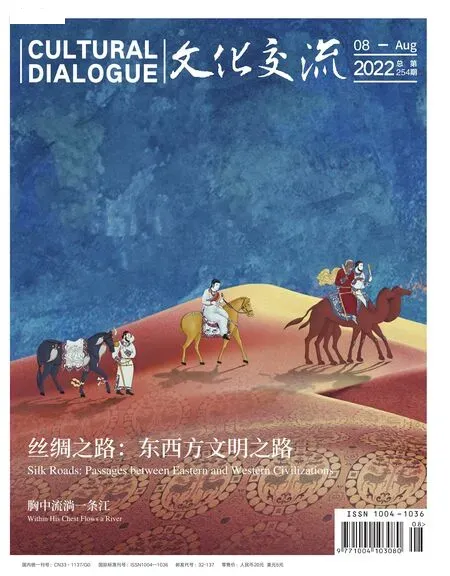常青:水墨世界的“入侵”者
文 /周 澍
无论何时,常青是那个走到哪里都能被一眼认出的人,即使他忘记他作为油画家的形象早已深入人心,即使他以与过往似乎无关的方式走进水墨的世界。
他的作品和他自身一样充满了不由分说的辨识度。无论他出于游戏精神还是苦心孤诣,他以水墨的线条、结构和意趣为我们呈现了一种强烈而颇具冒险精神的框架,并因其独特、当下而陌生的普适性,成为传统水墨世界的一名“闯入”者和“入侵”者。
特殊年份的一叠宣纸
油画家常青的水墨转向是在2003年。那年的空气充满着忧伤和茫然的氛围,常青在他运河边的工作室里,无意识地捻灭依然闪烁着红光的烟头,又同样无意识地把那双刚刚拿过油画笔的手,放置到水流不止的龙头下。
在“非典”时期的紧张感越来越占据人们心头的时候,公共媒体一遍遍地教育人们如何用正确的方法洗手。常青看着在流水中发呆、揉搓和翻转的手,不知道自己在想些什么。他的手指上还沾着少许菊花黄和橄榄绿的油画颜料,那是他在新闻里听到又一个医生离去时不小心留下的。
他意识到这将会是一个寒冷的年份,这个寒冷的年份呼唤他来做一些改变,或许可以使得冬天真正来临时不那么无助和沉重。而能够达成他这个心愿的,正是那水流中依然揉搓和翻转着的敏感之手。
当漫长的冬天终于离去,又一个冬天来临的时候,常青发现他那双敏感的手已经触摸过不同的绘画介质,其中包括色粉、丙烯和水彩。此后的几年,他穿梭行走在不同的材料和成品之间,没有预设也没有目的。那段给自己松绑的日子,一些东西被刻意回避和忽略,另一些东西则从来不需要想起,那时的常青充分享受一种特别自由的画画状态。
作为一种实验材料,隔壁国画系的师友们给常青送来了宣纸。宣纸的芬芳让他想起手拿毛笔的父亲以及父亲以毛笔作画的人生。童年时对父亲的崇拜和依然萦绕心头的氤氲墨香,让常青在美院附中毕业的那一年,几乎是不假思索地填报了中国美术学院国画系的志愿。而他以父亲为榜样的选择,却被父亲审时度势地进行了更改。父亲觉得儿子的造型能力和色彩感觉,若只是用来画国画恐怕是有点多了,于是父亲和任何一个有主见的家长一样,替常青作出了另一个更为高瞻远瞩的决定。
多年来常青在父亲选择的路上奋力向前,一直画油画的他尽己所能地把他所理解的油画画到了极致。
2017年的初夏时节,在上海,在那个叫“常识”的水墨个展研讨会上,常青说,始于2003年的探索是一次重启,这个重新建立和建构的过程,需要时间。因此除了国家重大题材定件,他很少再画其他的油画作品。他选择水墨的过程,就像他回到最初梦想和态度的过程。那是宿命,更像是天意!
不安的创作及其观看
作家余华曾经用简谱给《狂人日记》谱曲,音节之间的巨大落差和不加过渡让他有理由相信,如果那乐谱有机会被演奏出来,那一定是世上最不安的声音。
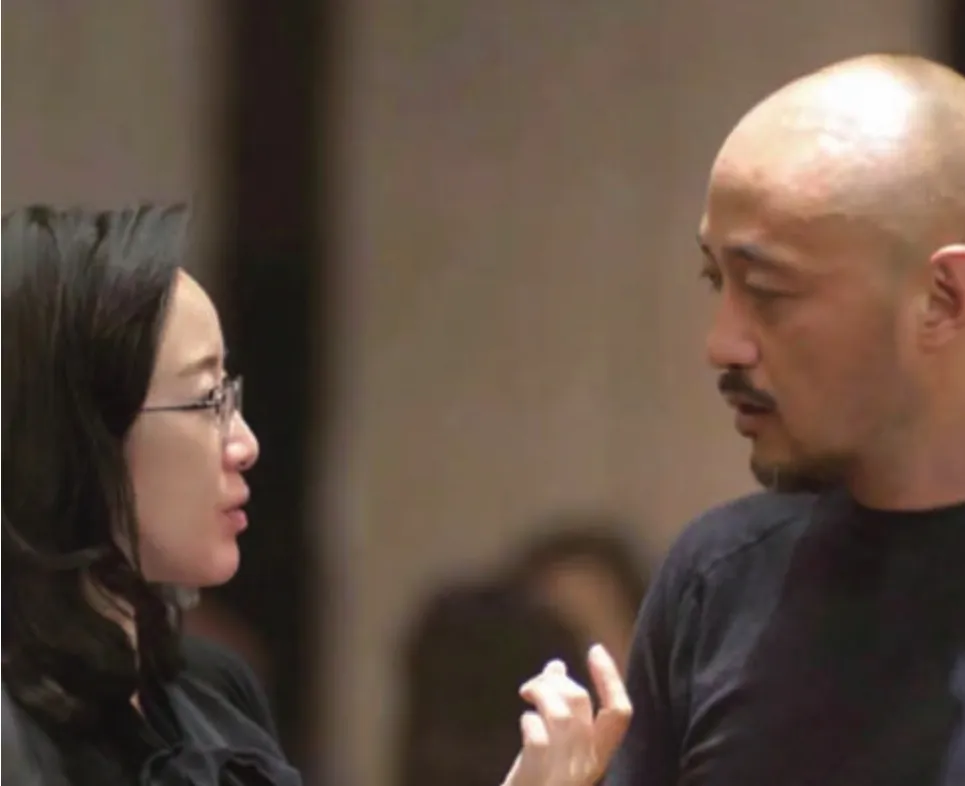
作者与常青。The author and Chang Qing.
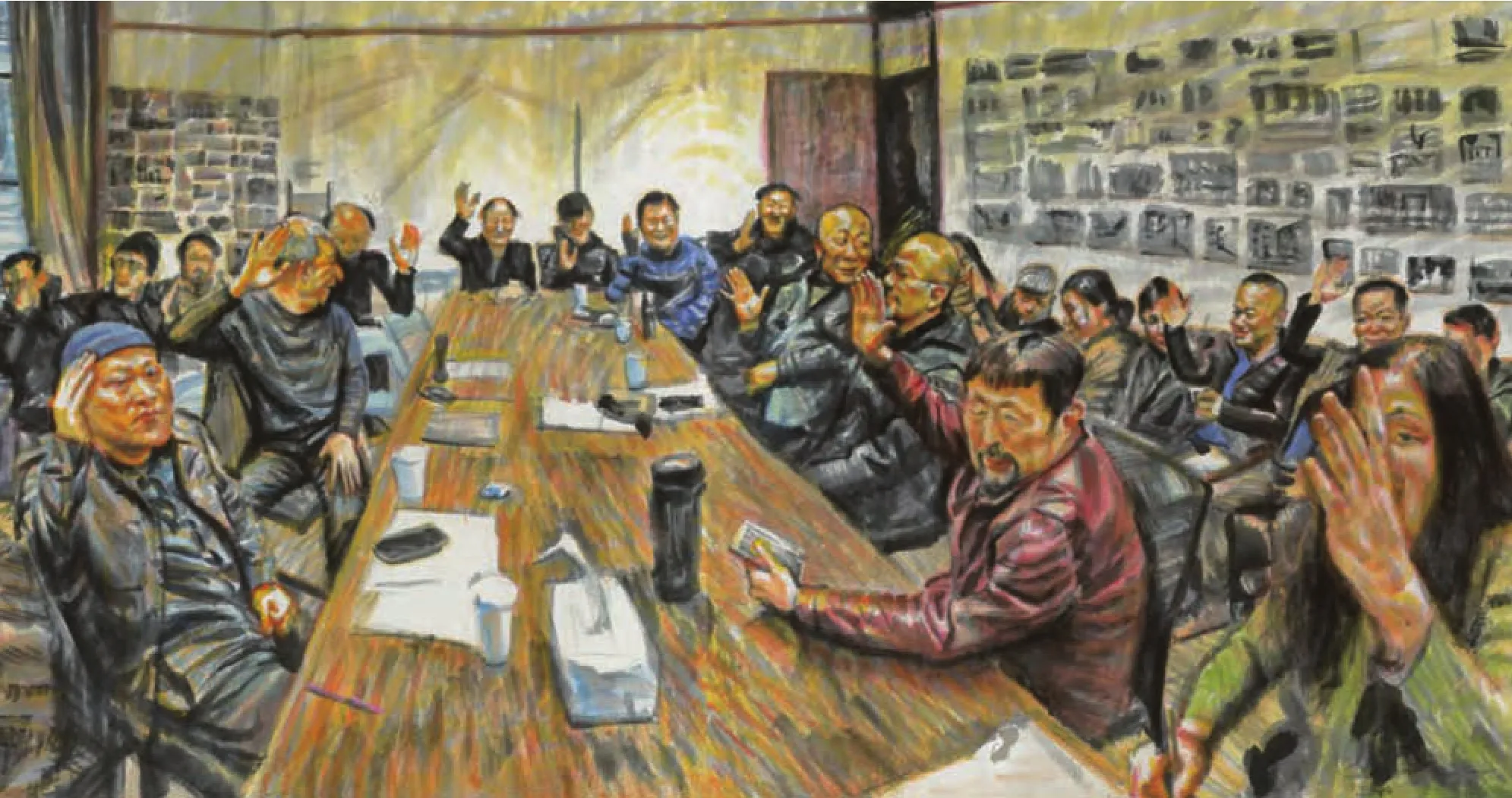
常青作品《开会》(局部)。Meeting (partial), an ink painting work by Chang Qing.
常青的水墨从他最初呈现的时候,已让人感觉到某种类似的不安,愈到后来,这不安相互交织,竟是再接再厉般地愈演愈烈了。
于是不安的常青拿着他的作品向国画系的老师请教,那曾是送给他宣纸的师友们。他们说,你不能教,你若是教了,要教坏的, 你就那样画下去好了。常青说,老师和朋友们不教他,他们就任由着他自顾自“野长”。他们虽不肯教,常青依然视他们为“同道中人”,他觉得自己与他们志趣相仿目标相同,于是他画下了他的《道友》系列作品,画下了他们开完会在门口等人又一起去聚会和参加活动的诸多情景。
也许不安的除了常青,恰恰还有他的“道友”们。因为常青, 这个来自油画系的后来人,就这样没有任何先见地,没心没肺地, 无所顾忌地画了他自以为是水墨的水墨,他的画和他们的如此不同, 带着他完全不自觉的颠覆性的挑战,大有要搅乱一潭清水的味道。
对于这一切,常青是木知木觉的,也从未有人跟他说起。他就像一个初尝创造快乐的小孩,继续他的水墨意兴和泼墨挥毫。
身为人父,常青多关注父子间的关系;又由于身为人子,他也同样多地关注母子的相处—在无数个父母子女的形象中,常青提炼出父子及母女间那目光相对的呼应,那向左或向右看齐的呆头呆脑,那手拉着手的大责任和小温情,以及各自闲坐沙发上的平和与满足。这些形象并不回避缺陷和怪诞,有时甚至还丑陋和奇异,但他们却是真实的生活和人伦,一如邻家的熟人或某个街头的古老记忆。
当常青继续他无人管教的“野长”,他还画了同一个背景前的系列肖像。如果他们是坐在那里的,他们有可能是某个渔民或海岛老人;若她们是站立着的,则可能是某个叫丹丹或张蕾又或者是小郭、小王的女孩。
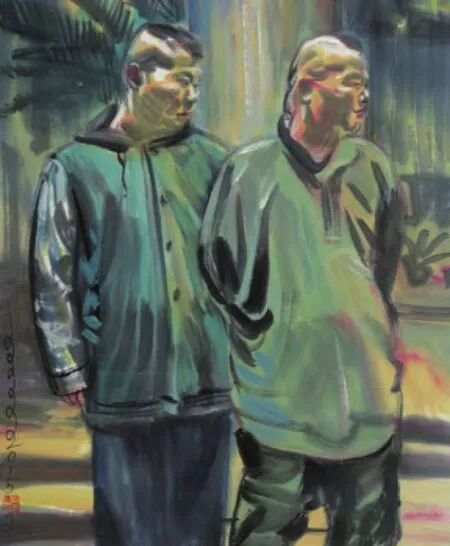
常青作品《父与子》。Father and Son, an ink painting work by Chang Qing.
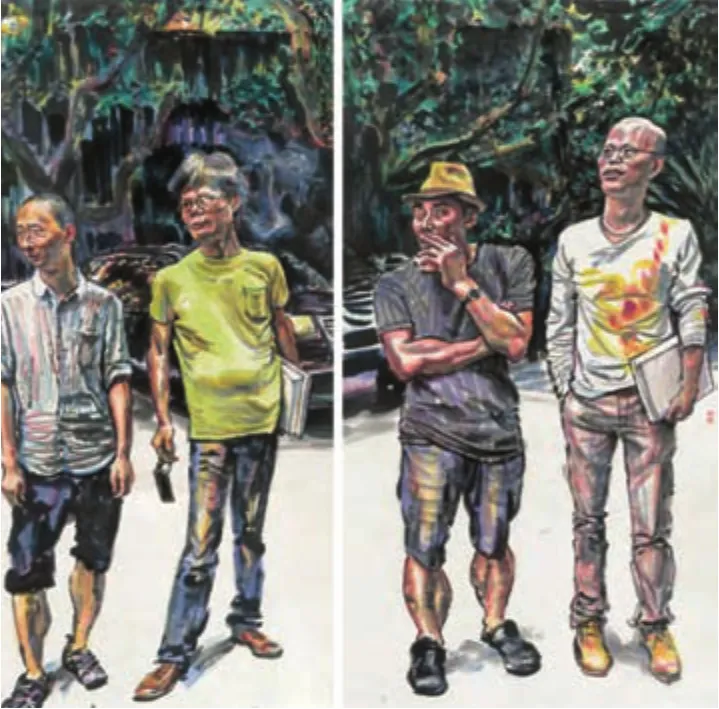
常青作品《道友》系列之一。One of the pieces from Kindred Spirits ink painting series by Chang Qing.

常青作品《推拿》。Massage, an ink painting work by Chang Qing.
如果常青在这组创意和笔法都碰巧与晚年霍克尼相类的画作上画出了瘾头,那么他会不会像霍克尼前辈那样,怀着对相对基础、简单甚至稚拙画法的深深偏好,最终绘制出1000幅这样的亲友肖像呢?
现在轮到评论家开始他们不安的发问了—杭州或者说浙派的水墨系统接受常青的水墨吗?常青和他的水墨会不会遭遇尴尬的身份认同呢?
我和你都是他作品中的某一个人
有人说,常青的水墨是《诗经》中的“国风”。
有人说,水墨艺术与现实主义之间存有很大的矛盾,常青把这种矛盾变小了,他对现实主义进行了接续。
更为意味深长的是,在英、法等国的巡展中,常青的水墨直接被域外的专家和艺术机构解读成了“一个当今的社会现实主义”。
《推拿》作为常青水墨的代表,是尤其令人印象深刻的一组。这组和毕飞宇的茅盾文学奖获奖小说同名的画作,同样地把最深切的关怀赋予了极易被忽视和忽略的社会群体,传递了素不相识的艺术家之间的默契。
常青水墨形象的丰富和多义远不止于此,除了油画家、设计师、老总与官员,服务员、钟点工、修鞋匠、耍猴人、瓜农与拾荒者—更多普通人的生存和生活样态进入了他的创作视域,激发着他的灵感、悲悯与热爱。
常青用生动和幽默感,逼真地记录了这些普通人掏心窝诉衷肠拉家常吹牛皮的形象,再现了他们跳广场舞时的炫酷和唱国歌时的豪迈。那拖着拉杆箱追逐边境风情的行者,那出入公共浴场却不忘谈论天下大事的男人,那像影子和风一样穿行在都市夜色里的女郎—那我们仿佛观察和历经过的一切,共同记录着我们和他者的相互打量,演绎着变革社会中的光怪陆离、风俗万象和勃勃生机。
当我们意识到你和我都可能是他作品中的某个人时,祖先亦幻化成鸟的形象飞进了常青的作品。类人猿将上肢高举头顶,是准备起跳、升腾和飞翔的姿态,他占据着画面的中心,也许只是因为他离人类最近。
常青的鹦鹉是瑰丽和妖娆的,一对色系相同又交叉分布的巨鸟,相向定格在类人猿左右,若是将她们美丽的形象重叠,那绮丽浓郁的色彩或将从此消失它们的边界。再往外侧,鸟的形象是不对称的两种,似乎要以此打破过于严谨的平衡结构。常青以五联画或者说五条屏的形式,呈现了他心目中完美飞翔的祖先。
2017年初夏的那个下午,在人头攒动的展厅,低调的常青反复被狂热的粉丝一次次逮住摄影留念,他们在“祖先”美丽的羽翼庇护下,一次次摆出当下的造型,又一次次露出古代的笑脸。
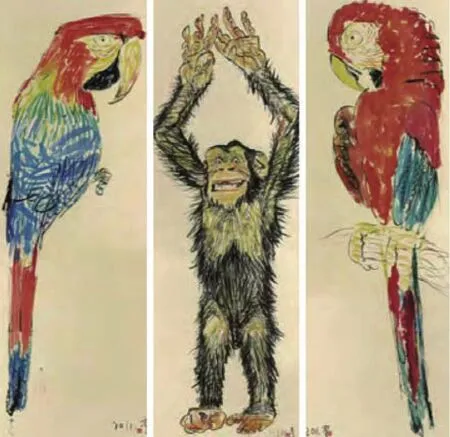
常青作品《鸟——祖先》(局部)。Birds — Ancestors (partial), an ink painting work by Chang Qing.
《使徒》与“罗克威尔情结”
常青水墨中将笔触伸得最远的,应该算那件叫作《使徒》的大作。《使徒》之大,一在于它的尺幅,二在于它时空上的渺远,三在于它所传达的抱负。《使徒》呈现了一群国美西画专业包括油画和雕塑系的老师们,在欧洲中世纪的一座古老教堂中观摩休息的场景。这是一群常青无比熟悉的朋友和同事,除了特别眷顾画面中唯一的女性形象,那领受了神示般的眼光和娟秀的面容,常青赋予其他的面容一律的疲倦与艰难,尽管那艰难本身互不相同、各有表现。在那个疲倦得有点登峰造极的好友崔小冬的身边,常青给自己留了一个空位,表明他应该是使徒中理所当然的一员。
饶有兴味的是,常青的使徒不是12个,即使加上那个属于他的空位也只有10个。画面两侧的边界部分,局部呈现的座位展示了它们无穷延伸的可能。因此常青的《使徒》一方面貌似跟神有关,另一方面又同时诙谐地解构了神性。
《使徒》对常青来说,毋宁是一种使命。游学西方,西学东渐,这如果不是华山一条路,至少也是深厚和业已习惯的传统。但是从油画到油画的以往,现在还要再生发出从油画到水墨的新旅。
在常青真实的“使徒”形象里,还有一个叫凯茜 · 蒂丽的美国女性,但她同样不是神的使徒。2013年夏日的某个午后,自带香槟和雪茄的凯茜 · 蒂丽优雅而没有任何预兆地叩开了常青工作室的大门。在短暂的寒暄过后,这个罗克威尔博物馆及基金会创办人的女儿,罗克威尔曾经的模特和长时期担任博物馆董事会核心成员的女人,迅速赢得了常青的友谊与敬重。
常青知道,他那些现实主义题材的水墨作品,有着对罗克威尔在表达时代特征、描绘普通人生活和幽默感等方面或多或少的体悟与追随。但有别于罗克威尔美国式的单纯和乐观,他的乐观背后更多了一些中国式的忧患和危机意识。在绘画手法上罗克威尔更接近绘画写实,他无疑更注重变形与表现。相对于罗克威尔更公众化和社会性的题材选择,他更偏爱以个人的方式直面具体的人物在具体环境和遭遇中的具体反映和情绪。罗克威尔图解了美国,他表现着中国。但对他来说,如何用手中的画笔记录和描绘自己的祖国和人民,却是一个远未完成的目标和使命。
吾生有涯,唯光阴最为宝贵。水墨克制讲述,有时仅三言两语, 它重形意,不恋“战”。水墨“多快好省”的属性和感觉符合常青对速度的预期和追求。水墨并不妨碍常青对油画的深深热爱和无限眷恋,那不断反复和深入带来的丰富与完满。水墨给常青另一种酣畅淋漓。
“常青的酣畅源自他深厚的西画功底,他作为专业画家的优秀品格,以及天赋异禀的聪慧和敏捷”,吴山明老师在见到常青的新水墨时,脸上是开怀的笑容。
于是,在氤氲的墨香和仙气里,我们看到一个老者和中年男子的拥抱,这是鹤发童颜的老一辈杰出浙派代表对常青新水墨的态度。常青这个曾经野蛮生长的水墨世界的“入侵”者,此刻也终于放下他的不安而获得了新的宁静。

常青作品《使徒》系列。The Apostles, a series of ink painting works by Chang Qing.
An “Interloper” in the World of Ink and Wash
By Zhou Shu
Whenever and wherever he goes, Chang Qing is the one to be recognized at first glance. As a well-established oil painter, he entered the world of ink-and-wash painting in a way seemingly irrelevant to his past.
His works are as immediately recognizable as his own self is.Whether in a playful spirit or in a painstaking effort, he presents ink paintings featuring intense and adventurous frameworks.His unique, contemporary and alien universality makes him an“interloper” and “invader” in the traditional ink-and-wash world.
Chang Qing’s shift of focus from oil painting to ink painting goes back to 2003, a year underlined by sadness and bewilderment.When working in his canal-side studio, habitually, he put out a cigarette, put down his brush and placed his hands under a running tap. It was a time when SARS was drawing attention and public media repeated tips for proper handwashing. Staring at his hands as they rubbed and scrubbed in the running water, Chang zoned out. Daisy-yellow and olive-green oil paints stained his fingers when he heard about another departed doctor in the news.
He realized that it was going to be a cold year, which called for a change, so that when winter finally came, he would feel less helpless and leaden. This depended on his nimble hands.When the long winter faded away and another winter arrived,Chang got acquainted with several painting mediums, including pastels, acrylics and watercolors. In the following years, he wandered around different materials and finished works without preconception or purpose. It was a period when he untied himself and enjoyed complete freedom in painting.
Teachers and friends from the Department of Traditional Chinese Painting sent over some Xuan paper as an experimental material, the scent of which reminded him of his father painting with a brush. Out of admiration for his father, he automatically applied for the Department of Traditional Chinese Painting at China Academy of Art upon graduation from the high school affiliated to Sichuan Fine Arts Institute. However, his choice to follow his father’s example was altered by his father, who believed that Chang’s modeling ability and sense of color would have been wasted if he chose to just study traditional Chinese painting. Thus,his father made a more far-sighted decision for his son, as any opinionated parent would. Over the years, Chang forged ahead on the path chosen by his father, going all out in oil painting. His choice of ink painting is like returning to the original aspiration. It is fate, more like predestined!
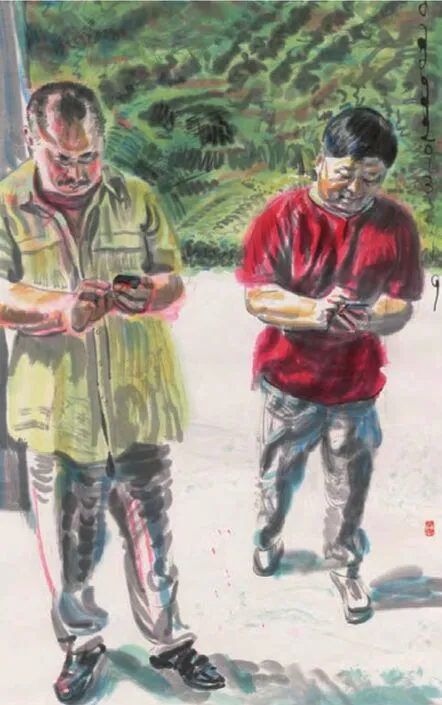
常青作品《存手机》。Depositing Cellphones, an ink painting work by Chang Qing.
Chang’s ink paintings present a feeling of unease from the very beginning, and going forward, such intertwined unease gets intensified. Feeling anxious, he sought advice from teachers of traditional Chinese painting, the friends who gave him Xuan paper. But they refused to tutor him and said that it would go wrong if they intervened. Chang was encouraged to “grow wild”and keep painting as it is. Nevertheless, he regarded them as fellow artists with shared interest and aspirations, and produced a series of works entitled, depicting them joining events or waiting at the door to catch up after a meeting.
Perhaps his fellow artists felt uneasy as well. Without precondition, deliberation or scruples, this latecomer from the Department of Oil Painting produced what he considered as ink painting, which is distinctive and brings unconscious but subversive challenges. Unaware of such a situation, nor told by anyone, Chang Qing, like a child who had the first taste of joy,continues his journey of ink and wash with great verve.
As a father and a son, he pays attention to parent-child relationships. Among countless images, he highlighted the fatherson and mother-daughter eye contacts, depicted them both looking to the left or right in a kind of frozen way, described the responsibility and love with their hands holding together, or peace and contentment of sitting idly on the sofa. These figures do not shy away from flaws and weirdness, and sometimes are even grotesque and bizarre, but they are true to life and ethics, like acquaintances in the neighborhood or memories of some street.Now it is the critics’ turn to worry: does the ink painting circle of Hangzhou or the Zhe (Zhejiang) School of Painting recognize Chang Qing’s style? Would there be an identity issue?
Some say that there is a great contradiction between ink art and realism. Chang Qing has mitigated such contradiction and built on realism. More significantly, during his travelling exhibitions in England, France, and other countries, his ink paintings were interpreted by foreign experts and art institutions as “a social realism of today”., as an impressive set of his representative ink paintings, shows his utmost solicitude for social groups that are easily overlooked and neglected.
He has touched upon multifarious and polysemous images other than oil painters, designers, CEOs and officials in ink painting. A variety of common people entered his vision of creation in the way they lived and survived, e.g., waiters, cleaners,shoemakers, monkey jugglers, melon farmers and scavengers,stimulating his inspiration, compassion and love.
His paintings are true to life. With a sense of humor, he recorded the conditions of common people chitchatting, bragging,singing and dancing. The traveler pulling his suitcases on a border trip, the man talking about global events in a public bath and the lady walking in urban night scenes like a shadow — all that we seem to have observed and experienced is an interpretation of the bizarreness, customs and vitality in the changing society.
His most far-reaching ink painting should be,which is grand in size and ambition, with temporal and spatial remoteness. It depicts a group of teachers from China Academy of Art observing a medieval church in Europe. They are close friends and colleagues to Chang Qing. Except for the only graceful female figure with a divine look, Chang applied fatigue and hardship to other faces in various ways. Next to his friend Cui Xiaodong, who looked over-wrought, Chang left a vacancy for himself, indicating himself as a fit member of the apostles. It is interesting to note that there aren’t 12 apostles, but 10 even with taking into account the vacancy for himself. The partially rendered seats on the border of both sides indicate the potential of in finite extension.
For Chang Qing,is rather a mission. It is an accustomed practice to introduce the Western culture to the East.In addition to the conventional approach of learning oil painting from oil painting, he embarked on a new journey meandering from oil painting to ink painting. Catharine Deely, former trustee of Norman Rockwell Museum, showed up in Chang’s life as an apostle, but not an apostle of God. During her unexpected visit on a summer afternoon in 2013, she made friends with and won respect from Chang.
Chang Qing’s ink paintings of realistic themes more or less draw inspiration from Rockwell in expressing the characteristics of the times, depicting ordinary people’s lives and conveying a sense of humor. Ink painting is narratively restrained and emphasizes the form and its implication, sometimes with just a few lines.The sense of going quick and easy fits Chang Qing’s expectations.But his pursuit of ink painting does not hold back his passion for oil painting, the built-up depth of which brings richness and completeness. Ink painting conveys another type of ease and delight, which, for Chang Qing, “originates from his solid Western painting skills, fine quality as a professional painter, and gifted intelligence and agility”, remarked Wu Shanming, a distinguished representative of the older generation of the Zhe School of Painting.
With lingering scent of ink, we see a cheerful senior hugging a middle-aged man and his novel style of ink painting. Now, this once wild “interloper” in the ink world has finally got relieved and regained peace.

